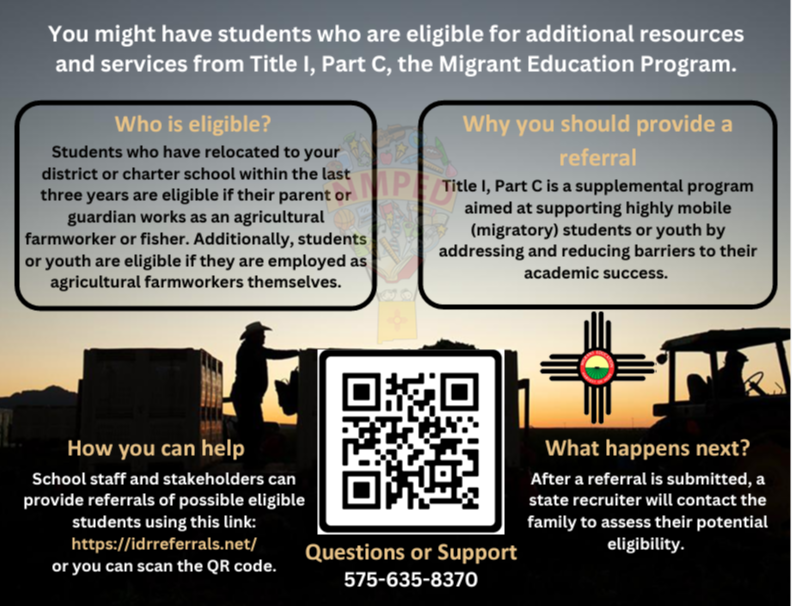Federal and State Programs
Title I
Title I Part A: Improving the Academic Achievement of the Disadvantaged
The Title I Part A program helps students in high poverty schools meet the same high academic standards expected of all children. Title I Part A funding is distributed to districts primarily based on poverty as determined by the US Census Bureau. Title I Part A funds are to be used to address specific educational needs of students as described in the school’s Educational Plan for Student Success (EPSS).

Title IV
Title IV, Part A is a U.S. Department of Education grant program authorized under the Elementary and Secondary Education Act (ESEA) which provides supplemental funding to help support student academic achievement and enrichment. This grant, also referred to as SSAE, Student Support and Academic Enrichment, awards Title IV, Part A funds to state educational agencies (SEAs), which then sub-grant funds to local education agencies (LEAs). Title IV, Part A program, may be referred to as “T4A”
Title IV Part A, Subpart 1 authorizes the expense of federal funds to support students and schools in three domains:
Well-rounded education
Safe and healthy students
Effective use of technology
Education for Homeless Children and Youth
FEDERAL DEFINITION OF A HOMELESS CHILD OR YOUTH
Students who qualify for this program include children and youth who lack a fixed, regular, and adequate nighttime residence.
The term includes—Children and youths who are:
sharing the housing of other persons due to loss of housing, economic hardship, or a similar reason (sometimes referred to as “doubled-up”);
living in motels, hotels, RV parks, or camping grounds due to lack of alternative adequate accommodations;
living in emergency or transitional shelters; or
abandoned in hospitals;
Children and youths who have a primary nighttime residence that is a public or private place not designed for, or ordinarily used as, a regular sleeping accommodation for human beings;
Children and youths who are living in cars, parks, public spaces, abandoned buildings, substandard housing, bus or train stations, or similar settings; and
Migratory children who qualify as homeless because they are living in circumstances described above.
If, due to a loss of housing, a child must live in a shelter, motel, vehicle, or campground, on the street, in abandoned buildings, or doubled-up with relatives or friends, then they are eligible to receive services provided under the McKinney-Vento Act.
Local Liaison:
575-734-5420 ext. 369
If you need further assistance with your children’s educational needs,
contact the National Center for Homeless Education:
1-800-308-2145 * homeless@serve.org * http://nche.ed.gov
Title III
Each Spring, Dexter English learner students take the ACCESS for ELLS® English Language Proficiency Assessment. This assessment determines our students' English language skills in the area of listening, speaking, reading and writing, a comprehension score (listening and reading scores combined) and an overall score.
This assessment identifies language skills in both social and academic English. Social language is used to communicate for everyday purposes. Academic language is used to communicate in the content of language arts, mathematics, science and social studies.
If a student earns an overall score of 4.7 or better, they are deemed proficient in English. Congratulations to our Dexter English learners (ELs) who score proficient!
Title IX
TITLE IX COORDINATOR
Jamie Watson
PreK-12 Programs Director
PO Box 159
100 N Lincoln
Dexter, NM 88230
575.734.5420, Ext. 371
Title IX & Nondiscrimination
ESSER III/ARP
Migrant Education Program
At the time of enrollment, every family completes an “Occupational Questionnaire”. Once this form is completed, the Migrant Education Department receives a notification and makes the referral. Based on the questionnaire, if the student meets the following criteria, the student is eligible to participate in the Migrant Education Program:
Age: The child is younger than 22; and
Educational level: The child has not graduated from high school or does not hold a high school equivalency certificate (GED); and
Move: The child move with or to join a migratory worker for economic necessity across School District lines; and
The time of the move: The move occurred in the preceding 36 months.
What is the Migrant Education Program?
Migrant Education is a United States Department of Education program that provides supplemental educational and support services to eligible migrant children. These services help children of migrant workers overcome the disruption to their education and other obstacles they encounter. The Migrant Education Program is based on the premise that poverty, mobility and school achievement are related and that children who are both poor and migratory are more likely to have difficulty in school.

Chris Chairez
Regional Migrant Recruiter
email Chris Chairez
Tel: 575-728-4679
Fax:575-527-5865

